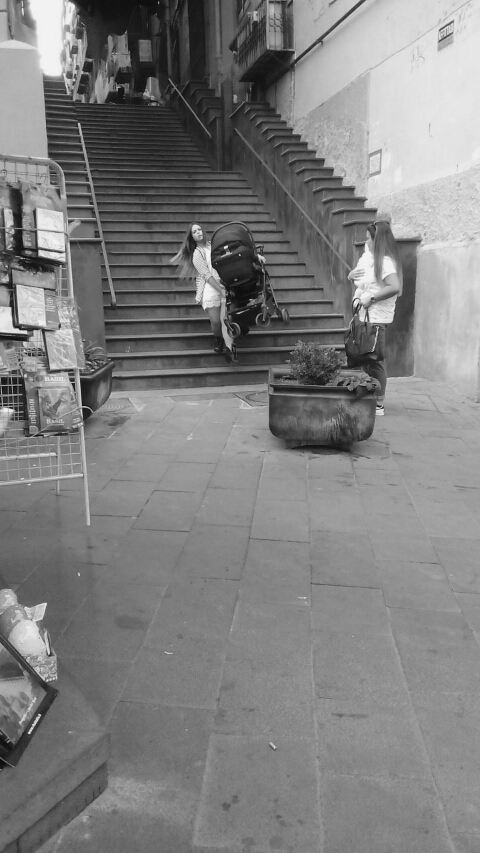This image may seem staged or simply a still frame taken from a super-heroine blockbuster film, yet, it is a street-photo taken with a cellphone. A daily life, out of the screen scene. The young woman, taking the last step of what seems to be the never-ending stairway of Odessa, concentrates visually in this frozen moment, most of the tensions that permeate the making of ‘motherhood’ in everyday life of women living today both, in the city of Naples (were the image was produced) and in any other ordinary city (Robinson, 2009). In every part of the world, women are called to reconcile the demands of society and their own expectations, playing up an act of (un)balance between demands of social reproduction and personal success, other than dealing with the material implications of the need to perform such (un)balancing act.
Feminist scholars and activists have long called for the unveiling of the political and material implications of power relations constructed between the private and the public spheres, between the household scale and that of the state (Fraser and Gordon, 1992). As welfare regimes constructed their provision model on the image of the male bread-winner, another tacit contract was structured through the gendered division of paid and unpaid work, normalizing the construction of the figure of waged male bread-winner and that of a female dependent care-giver (England, 2007). Through diverse arrangements of welfare provision, different countries took off pressure from women as the only care-givers, producing an uneven geography of relief from these pressures. Along with the diversified relief offered by the different Welfare Regimes (Esping-Andersen, 2013) there was also the opening of the paid working sphere to women. Still, the tensions derived from the social construction of motherhood and its material constraints continues reinforce and maintain gender inequalities everywhere. For example, up to date academic literature from diverse fields have effectively shown that there is an effective motherhood wage penalty taking place today in many countries, added to the well documented payment gap based on gender.
By looking back at the image, this sociological reflection is amplified. Depicting a scene commonly lived/seen in the city of Naples, this image reminds us of the need to rematerialize the environment in which social actions take place when pursuing sociological research. The image of this young woman, Sara, who also happens to be a mother, enriches our understanding of the material (in)accessibility to the city by a person with a baby. We can’t help but to acknowledge the massive presence of the stairs, imagine the heavy weight of the trolley, accompany her in the counting of the steps and feel the empathic relief of her arrival to the end. I situate my research on this line, trying to better understand the visible and invisible mechanisms that enable or prevent women in motherhood to access the city and its resources.
England, K. (2007). Welfare provision, welfare reform, welfare mothers. KCox, MLow and JRobinson (eds) Handbook of Political Geography, 141-153.
Esping-Andersen, G. (2013). The three worlds of welfare capitalism: John Wiley & Sons.
Fraser, N. (2009). Scales of justice: Reimagining political space in a globalizing world: Columbia University Press.

Commentary on Rachel Tanur's Works: Chinese Laundry